Chen Wei
SMPLest-X: Ultimate Scaling for Expressive Human Pose and Shape Estimation
Jan 16, 2025Abstract:Expressive human pose and shape estimation (EHPS) unifies body, hands, and face motion capture with numerous applications. Despite encouraging progress, current state-of-the-art methods focus on training innovative architectural designs on confined datasets. In this work, we investigate the impact of scaling up EHPS towards a family of generalist foundation models. 1) For data scaling, we perform a systematic investigation on 40 EHPS datasets, encompassing a wide range of scenarios that a model trained on any single dataset cannot handle. More importantly, capitalizing on insights obtained from the extensive benchmarking process, we optimize our training scheme and select datasets that lead to a significant leap in EHPS capabilities. Ultimately, we achieve diminishing returns at 10M training instances from diverse data sources. 2) For model scaling, we take advantage of vision transformers (up to ViT-Huge as the backbone) to study the scaling law of model sizes in EHPS. To exclude the influence of algorithmic design, we base our experiments on two minimalist architectures: SMPLer-X, which consists of an intermediate step for hand and face localization, and SMPLest-X, an even simpler version that reduces the network to its bare essentials and highlights significant advances in the capture of articulated hands. With big data and the large model, the foundation models exhibit strong performance across diverse test benchmarks and excellent transferability to even unseen environments. Moreover, our finetuning strategy turns the generalist into specialist models, allowing them to achieve further performance boosts. Notably, our foundation models consistently deliver state-of-the-art results on seven benchmarks such as AGORA, UBody, EgoBody, and our proposed SynHand dataset for comprehensive hand evaluation. (Code is available at: https://github.com/wqyin/SMPLest-X).
VideoDPO: Omni-Preference Alignment for Video Diffusion Generation
Dec 18, 2024



Abstract:Recent progress in generative diffusion models has greatly advanced text-to-video generation. While text-to-video models trained on large-scale, diverse datasets can produce varied outputs, these generations often deviate from user preferences, highlighting the need for preference alignment on pre-trained models. Although Direct Preference Optimization (DPO) has demonstrated significant improvements in language and image generation, we pioneer its adaptation to video diffusion models and propose a VideoDPO pipeline by making several key adjustments. Unlike previous image alignment methods that focus solely on either (i) visual quality or (ii) semantic alignment between text and videos, we comprehensively consider both dimensions and construct a preference score accordingly, which we term the OmniScore. We design a pipeline to automatically collect preference pair data based on the proposed OmniScore and discover that re-weighting these pairs based on the score significantly impacts overall preference alignment. Our experiments demonstrate substantial improvements in both visual quality and semantic alignment, ensuring that no preference aspect is neglected. Code and data will be shared at https://videodpo.github.io/.
GenEx: Generating an Explorable World
Dec 12, 2024Abstract:Understanding, navigating, and exploring the 3D physical real world has long been a central challenge in the development of artificial intelligence. In this work, we take a step toward this goal by introducing GenEx, a system capable of planning complex embodied world exploration, guided by its generative imagination that forms priors (expectations) about the surrounding environments. GenEx generates an entire 3D-consistent imaginative environment from as little as a single RGB image, bringing it to life through panoramic video streams. Leveraging scalable 3D world data curated from Unreal Engine, our generative model is rounded in the physical world. It captures a continuous 360-degree environment with little effort, offering a boundless landscape for AI agents to explore and interact with. GenEx achieves high-quality world generation, robust loop consistency over long trajectories, and demonstrates strong 3D capabilities such as consistency and active 3D mapping. Powered by generative imagination of the world, GPT-assisted agents are equipped to perform complex embodied tasks, including both goal-agnostic exploration and goal-driven navigation. These agents utilize predictive expectation regarding unseen parts of the physical world to refine their beliefs, simulate different outcomes based on potential decisions, and make more informed choices. In summary, we demonstrate that GenEx provides a transformative platform for advancing embodied AI in imaginative spaces and brings potential for extending these capabilities to real-world exploration.
ScienceAgentBench: Toward Rigorous Assessment of Language Agents for Data-Driven Scientific Discovery
Oct 07, 2024



Abstract:The advancements of language language models (LLMs) have piqued growing interest in developing LLM-based language agents to automate scientific discovery end-to-end, which has sparked both excitement and skepticism about the true capabilities of such agents. In this work, we argue that for an agent to fully automate scientific discovery, it must be able to complete all essential tasks in the workflow. Thus, we call for rigorous assessment of agents on individual tasks in a scientific workflow before making bold claims on end-to-end automation. To this end, we present ScienceAgentBench, a new benchmark for evaluating language agents for data-driven scientific discovery. To ensure the scientific authenticity and real-world relevance of our benchmark, we extract 102 tasks from 44 peer-reviewed publications in four disciplines and engage nine subject matter experts to validate them. We unify the target output for every task to a self-contained Python program file and employ an array of evaluation metrics to examine the generated programs, execution results, and costs. Each task goes through multiple rounds of manual validation by annotators and subject matter experts to ensure its annotation quality and scientific plausibility. We also propose two effective strategies to mitigate data contamination concerns. Using our benchmark, we evaluate five open-weight and proprietary LLMs, each with three frameworks: direct prompting, OpenHands, and self-debug. Given three attempts for each task, the best-performing agent can only solve 32.4% of the tasks independently and 34.3% with expert-provided knowledge. These results underscore the limited capacities of current language agents in generating code for data-driven discovery, let alone end-to-end automation for scientific research.
GRPose: Learning Graph Relations for Human Image Generation with Pose Priors
Aug 29, 2024Abstract:Recent methods using diffusion models have made significant progress in human image generation with various additional controls such as pose priors. However, existing approaches still struggle to generate high-quality images with consistent pose alignment, resulting in unsatisfactory outputs. In this paper, we propose a framework delving into the graph relations of pose priors to provide control information for human image generation. The main idea is to establish a graph topological structure between the pose priors and latent representation of diffusion models to capture the intrinsic associations between different pose parts. A Progressive Graph Integrator (PGI) is designed to learn the spatial relationships of the pose priors with the graph structure, adopting a hierarchical strategy within an Adapter to gradually propagate information across different pose parts. A pose perception loss is further introduced based on a pretrained pose estimation network to minimize the pose differences. Extensive qualitative and quantitative experiments conducted on the Human-Art and LAION-Human datasets demonstrate that our model achieves superior performance, with a 9.98% increase in pose average precision compared to the latest benchmark model. The code is released on *******.
CoCoG-2: Controllable generation of visual stimuli for understanding human concept representation
Jul 20, 2024Abstract:Humans interpret complex visual stimuli using abstract concepts that facilitate decision-making tasks such as food selection and risk avoidance. Similarity judgment tasks are effective for exploring these concepts. However, methods for controllable image generation in concept space are underdeveloped. In this study, we present a novel framework called CoCoG-2, which integrates generated visual stimuli into similarity judgment tasks. CoCoG-2 utilizes a training-free guidance algorithm to enhance generation flexibility. CoCoG-2 framework is versatile for creating experimental stimuli based on human concepts, supporting various strategies for guiding visual stimuli generation, and demonstrating how these stimuli can validate various experimental hypotheses. CoCoG-2 will advance our understanding of the causal relationship between concept representations and behaviors by generating visual stimuli. The code is available at \url{https://github.com/ncclab-sustech/CoCoG-2}.
TrAME: Trajectory-Anchored Multi-View Editing for Text-Guided 3D Gaussian Splatting Manipulation
Jul 02, 2024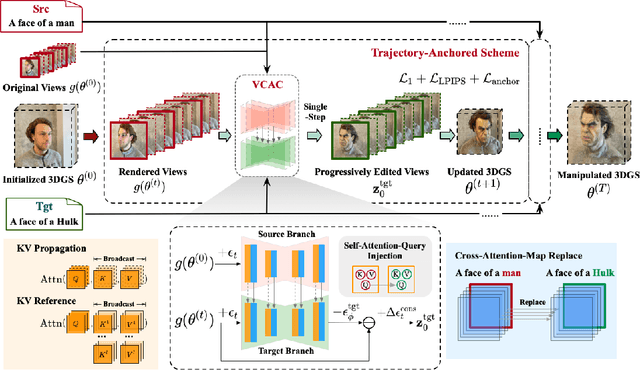
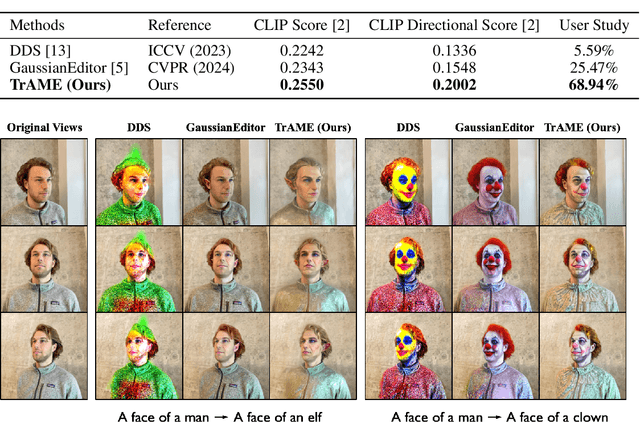

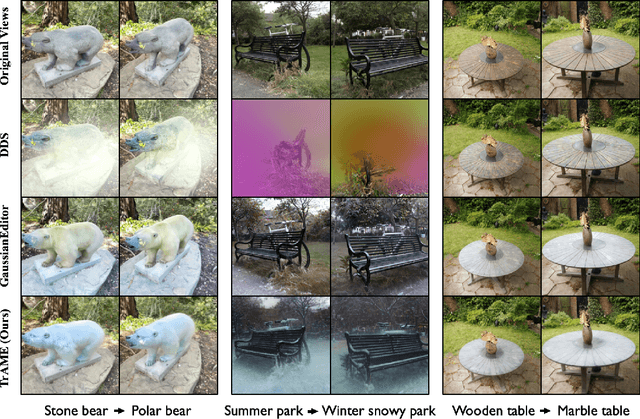
Abstract:Despite significant strides in the field of 3D scene editing, current methods encounter substantial challenge, particularly in preserving 3D consistency in multi-view editing process. To tackle this challenge, we propose a progressive 3D editing strategy that ensures multi-view consistency via a Trajectory-Anchored Scheme (TAS) with a dual-branch editing mechanism. Specifically, TAS facilitates a tightly coupled iterative process between 2D view editing and 3D updating, preventing error accumulation yielded from text-to-image process. Additionally, we explore the relationship between optimization-based methods and reconstruction-based methods, offering a unified perspective for selecting superior design choice, supporting the rationale behind the designed TAS. We further present a tuning-free View-Consistent Attention Control (VCAC) module that leverages cross-view semantic and geometric reference from the source branch to yield aligned views from the target branch during the editing of 2D views. To validate the effectiveness of our method, we analyze 2D examples to demonstrate the improved consistency with the VCAC module. Further extensive quantitative and qualitative results in text-guided 3D scene editing indicate that our method achieves superior editing quality compared to state-of-the-art methods. We will make the complete codebase publicly available following the conclusion of the double-blind review process.
ARVideo: Autoregressive Pretraining for Self-Supervised Video Representation Learning
May 24, 2024



Abstract:This paper presents a new self-supervised video representation learning framework, ARVideo, which autoregressively predicts the next video token in a tailored sequence order. Two key designs are included. First, we organize autoregressive video tokens into clusters that span both spatially and temporally, thereby enabling a richer aggregation of contextual information compared to the standard spatial-only or temporal-only clusters. Second, we adopt a randomized spatiotemporal prediction order to facilitate learning from multi-dimensional data, addressing the limitations of a handcrafted spatial-first or temporal-first sequence order. Extensive experiments establish ARVideo as an effective paradigm for self-supervised video representation learning. For example, when trained with the ViT-B backbone, ARVideo competitively attains 81.2% on Kinetics-400 and 70.9% on Something-Something V2, which are on par with the strong benchmark set by VideoMAE. Importantly, ARVideo also demonstrates higher training efficiency, i.e., it trains 14% faster and requires 58% less GPU memory compared to VideoMAE.
CoCoG: Controllable Visual Stimuli Generation based on Human Concept Representations
Apr 25, 2024Abstract:A central question for cognitive science is to understand how humans process visual objects, i.e, to uncover human low-dimensional concept representation space from high-dimensional visual stimuli. Generating visual stimuli with controlling concepts is the key. However, there are currently no generative models in AI to solve this problem. Here, we present the Concept based Controllable Generation (CoCoG) framework. CoCoG consists of two components, a simple yet efficient AI agent for extracting interpretable concept and predicting human decision-making in visual similarity judgment tasks, and a conditional generation model for generating visual stimuli given the concepts. We quantify the performance of CoCoG from two aspects, the human behavior prediction accuracy and the controllable generation ability. The experiments with CoCoG indicate that 1) the reliable concept embeddings in CoCoG allows to predict human behavior with 64.07\% accuracy in the THINGS-similarity dataset; 2) CoCoG can generate diverse objects through the control of concepts; 3) CoCoG can manipulate human similarity judgment behavior by intervening key concepts. CoCoG offers visual objects with controlling concepts to advance our understanding of causality in human cognition. The code of CoCoG is available at \url{https://github.com/ncclab-sustech/CoCoG}.
AiOS: All-in-One-Stage Expressive Human Pose and Shape Estimation
Mar 26, 2024
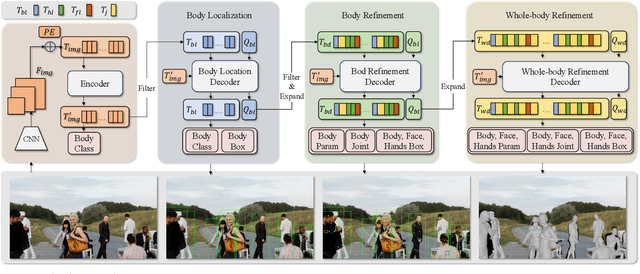
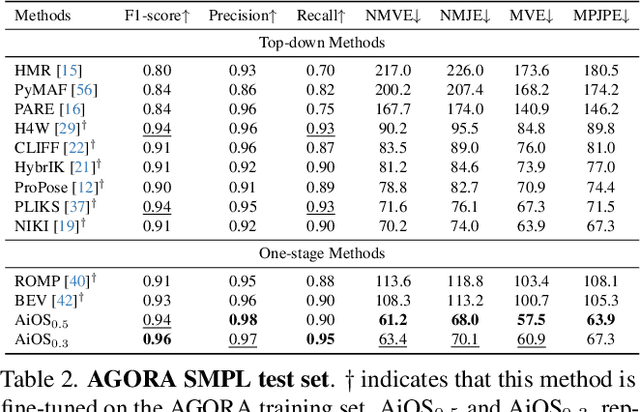
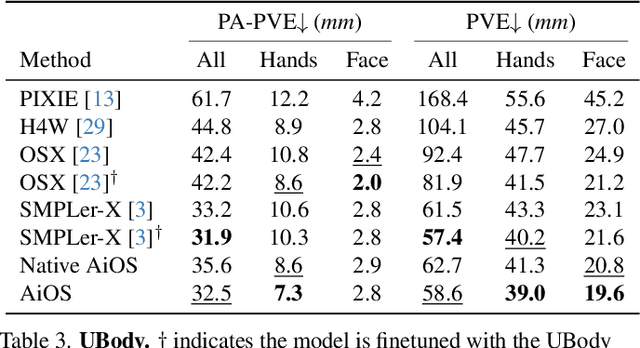
Abstract:Expressive human pose and shape estimation (a.k.a. 3D whole-body mesh recovery) involves the human body, hand, and expression estimation. Most existing methods have tackled this task in a two-stage manner, first detecting the human body part with an off-the-shelf detection model and inferring the different human body parts individually. Despite the impressive results achieved, these methods suffer from 1) loss of valuable contextual information via cropping, 2) introducing distractions, and 3) lacking inter-association among different persons and body parts, inevitably causing performance degradation, especially for crowded scenes. To address these issues, we introduce a novel all-in-one-stage framework, AiOS, for multiple expressive human pose and shape recovery without an additional human detection step. Specifically, our method is built upon DETR, which treats multi-person whole-body mesh recovery task as a progressive set prediction problem with various sequential detection. We devise the decoder tokens and extend them to our task. Specifically, we first employ a human token to probe a human location in the image and encode global features for each instance, which provides a coarse location for the later transformer block. Then, we introduce a joint-related token to probe the human joint in the image and encoder a fine-grained local feature, which collaborates with the global feature to regress the whole-body mesh. This straightforward but effective model outperforms previous state-of-the-art methods by a 9% reduction in NMVE on AGORA, a 30% reduction in PVE on EHF, a 10% reduction in PVE on ARCTIC, and a 3% reduction in PVE on EgoBody.
 Add to Chrome
Add to Chrome Add to Firefox
Add to Firefox Add to Edge
Add to Edge